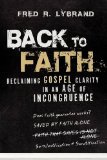Back to Faith: Reclaiming Gospel Clarity in an Age of Incongruence. By Fred R. Lybrand. NP: Xulon Press, 2009. 297 pp. Paper, $18.99.
Seven of the eight chapters have the words the cliché in them. The cliché in question, attributed to John Calvin, is stated in the preface and the start of Chap. 1 as well: “It is therefore faith alone which justifies, and yet the faith which justifies is not alone” (pp. ix, 3). Thus the question being considered in light of Calvin’s famous dictum is this: does faith guarantee works?
The word cliché might be seen by some to be a bit negative. Possibly a word like dictum would have been a better choice.
The chapter titles, as well as the title and subtitle of the entire book, fail to clarify what each is about and fail to draw the reader in.
The title would have been better if it incorporated the message of the cliché/dictum in some way. Here is one option: The Faith that Saves Is Indeed Alone: Good Works Are Neither a Proof Nor Condition of Eternal Life. Another possible title and subtitle would be: Faith Alone Saves in Spite of What Theologians Are Saying: Calvin’s Famous Dictum Reconsidered.
One of the most powerful chapters was Chap. 2: “The Cliché is Logically Invalid.” Lybrand shows how this seemingly sound saying is actually logically impossible. Salvation cannot be by faith alone and yet not by faith alone. It is either by faith alone or it is not by faith alone.
In this chapter the author introduces something called a “causal array.” It is a box with two potentially related items (like good parents and good children) and then a series of plusses and minuses. While some of these are fairly easy to figure out, I think it would have been more reader friendly to simply state the point without the boxes and symbols (and in some cases shading too). Once these boxes arrived, the discussion seemed more esoteric.
The next chapter, Chap. 3, is entitled, “The Cliché is Theologically Invalid.” It is a bit brief, but helpful. The author does a good job of showing how Calvin and others end up contradicting themselves when discussing texts like James 2.
Chapter 4 shows how the dictum is exegetically flawed by examining Jas 2:14-26. The discussion is very good. Evidently Lybrand chose to limit his discussion to this one passage in this chapter so as to keep its length down. Yet in Chap. 6 he continues the discussion by looking at a number of other texts. It might have been wise to shorten the discussion of James 2 slightly and to include the discussion from Chap. 6 here. Or, since these are two long chapters, they could have been placed back to back. It is not clear why a chapter on pragmatic concerns (Chap. 5) intervenes between these two chapters.
Chapter 7, on John Piper’s use of the cliché, is a very powerful one.
For those familiar with the writings of Zane Hodges, Jody Dillow, and other Free Grace writers, most of what is in this book is not new. The author basically is restating what others have written. Still, the material is helpful, especially for those who have not read all of the Free Grace literature.
Though the author has been involved in the so-called crossless gospel controversy, he does not engage that discussion here. Clearly he is writing to a larger audience than simply people attuned to that issue. It is surprising, however, that he does not actually say what the object of saving faith is in a book dealing with saving faith and “reclaiming gospel clarity.” Possibly that is because Lybrand’s focus is not precisely on the content of saving faith, but is rather on the issue of the supposed inevitability of good works. Even so, it would have been helpful if he had discussed, at least briefly, the object of saving faith at some point.
There are no Scripture or subject indexes. They would have been helpful.
In spite of some weaknesses, there is much helpful information in this book. I recommend it.
Robert N. Wilkin
Editor
Journal of the Grace Evangelical Society
Denton, Texas


